ASX Glossary - Z: Difference between revisions
Jump to navigation
Jump to search
No edit summary |
No edit summary |
||
| (One intermediate revision by the same user not shown) | |||
| Line 149: | Line 149: | ||
<body> | <body> | ||
<table> | <table> | ||
<tr | <tr> | ||
<td class="term"> | <td class="term"> | ||
<a href="https://wiki.alsresume.com/index.php?title= | <a href="https://wiki.alsresume.com/index.php?title=Drag_coefficient" target="_blank" | ||
style="color: #40E0D0; font-weight: bold; text-decoration: none; cursor: pointer;" | style="color: #40E0D0; font-weight: bold; text-decoration: none; cursor: pointer;" | ||
onmouseover="this.style.color='#ff4f01';" | onmouseover="this.style.color='#ff4f01';" | ||
onmouseout="this.style.color='#40E0D0';"> | onmouseout="this.style.color='#40E0D0';">Zero Drag Coefficient</a> | ||
</td> | |||
<td class="description">The zero drag coefficient is the baseline measure of drag for an aircraft in ideal conditions. It is used to evaluate aerodynamic efficiency and design improvements.</td> | |||
<td class="image-column"><img src="https://www.alsresume.com/wp-content/uploads/2025/02/Zero-Drag-Coefficient.jpg" alt="Zero Drag Coefficient"></td> | |||
</tr> | |||
</tr> | |||
<tr | <tr> | ||
<td class="term"> | <td class="term"> | ||
<a href="https://wiki.alsresume.com/index.php?title= | <a href="https://wiki.alsresume.com/index.php?title=Zero-Drag_Configuration" target="_blank" | ||
style="color: #40E0D0; font-weight: bold; text-decoration: none; cursor: pointer;" | style="color: #40E0D0; font-weight: bold; text-decoration: none; cursor: pointer;" | ||
onmouseover="this.style.color='#ff4f01';" | onmouseover="this.style.color='#ff4f01';" | ||
onmouseout="this.style.color='#40E0D0';"> | onmouseout="this.style.color='#40E0D0';">Zero-Drag Configuration</a> | ||
</td> | |||
<td class="description">A zero-drag configuration minimizes aerodynamic drag by optimizing the aircraft’s shape and design. Engineers use advanced materials and streamlined components to achieve this, enhancing fuel efficiency and performance.</td> | |||
<td class="image-column"><img src="https://www.alsresume.com/wp-content/uploads/2025/02/Zero-Drag-Configuration.jpg" alt="Zero-Drag Configuration"></td> | |||
</tr> | |||
</tr> | |||
<tr | <tr> | ||
<td class="term"> | <td class="term"> | ||
<a href="https://wiki.alsresume.com/index.php?title= | <a href="https://wiki.alsresume.com/index.php?title=Zero-Fuel_Range" target="_blank" | ||
style="color: #40E0D0; font-weight: bold; text-decoration: none; cursor: pointer;" | style="color: #40E0D0; font-weight: bold; text-decoration: none; cursor: pointer;" | ||
onmouseover="this.style.color='#ff4f01';" | onmouseover="this.style.color='#ff4f01';" | ||
onmouseout="this.style.color='#40E0D0';"> | onmouseout="this.style.color='#40E0D0';">Zero-Fuel Range</a> | ||
</td> | |||
<td class="description">Zero-fuel range is the maximum distance an aircraft can fly without additional fuel onboard. This metric is used in performance planning and payload optimization, especially for long-haul flights.</td> | |||
<td class="image-column"><img src="https://www.alsresume.com/wp-content/uploads/2025/02/Zero-Fuel-Range.jpg" alt="Zero-Fuel Range"></td> | |||
</tr> | </tr> | ||
<tr | <tr> | ||
<td class="term"> | <td class="term"> | ||
<a href="https://wiki.alsresume.com/index.php?title= | <a href="https://wiki.alsresume.com/index.php?title=Zero-Fuel_Weight_(ZFW)" target="_blank" | ||
style="color: #40E0D0; font-weight: bold; text-decoration: none; cursor: pointer;" | style="color: #40E0D0; font-weight: bold; text-decoration: none; cursor: pointer;" | ||
onmouseover="this.style.color='#ff4f01';" | onmouseover="this.style.color='#ff4f01';" | ||
onmouseout="this.style.color='#40E0D0';"> | onmouseout="this.style.color='#40E0D0';">Zero-Fuel Weight (ZFW)</a> | ||
</td> | |||
<td class="description">Zero-fuel weight is the total aircraft weight without usable fuel. It includes the aircraft's structure, payload (passengers, cargo), and crew. ZFW is critical for calculating maximum takeoff weight and fuel load, ensuring the aircraft operates safely within structural and performance limits.<td class="image-column"><img src="https://www.alsresume.com/wp-content/uploads/2025/02/zero-fuel-weight.png" alt="Zero-G Flight"></td> | |||
</td> | |||
<tr> | |||
</ | |||
<tr | |||
<td class="term"> | <td class="term"> | ||
<a href="https://wiki.alsresume.com/index.php?title= | <a href="https://wiki.alsresume.com/index.php?title=Reduced-gravity_aircraft#External_links" target="_blank" | ||
style="color: #40E0D0; font-weight: bold; text-decoration: none; cursor: pointer;" | style="color: #40E0D0; font-weight: bold; text-decoration: none; cursor: pointer;" | ||
onmouseover="this.style.color='#ff4f01';" | onmouseover="this.style.color='#ff4f01';" | ||
onmouseout="this.style.color='#40E0D0';"> | onmouseout="this.style.color='#40E0D0';">Zero-G Flight</a> | ||
</td> | |||
<td class="description">A zero-G flight simulates weightlessness by flying a parabolic trajectory. Used for astronaut training, scientific experiments, and recreational experiences, these flights provide moments of zero gravity during freefall phases.</td> | |||
<td class="image-column"><img src="https://www.alsresume.com/wp-content/uploads/2025/02/Zero-Gravity.png" alt="Zero-G Flight"></td> | |||
</tr> | </tr> | ||
<tr | <tr> | ||
<td class="term"> | <td class="term"> | ||
<a href="https://wiki.alsresume.com/index.php?title= | <a href="https://wiki.alsresume.com/index.php?title=Zero-Latency_Response" target="_blank" | ||
style="color: #40E0D0; font-weight: bold; text-decoration: none; cursor: pointer;" | style="color: #40E0D0; font-weight: bold; text-decoration: none; cursor: pointer;" | ||
onmouseover="this.style.color='#ff4f01';" | onmouseover="this.style.color='#ff4f01';" | ||
onmouseout="this.style.color='#40E0D0';"> | onmouseout="this.style.color='#40E0D0';">Zero-Latency Response</a> | ||
</td> | |||
<td class="description">Zero-latency response refers to instantaneous inputs from flight controls or systems, ensuring immediate reactions during critical maneuvers or emergencies.</td> | |||
<td class="image-column"><img src="https://www.alsresume.com/wp-content/uploads/2025/02/Zero.png" alt="Zero-Latency Response"></td> | |||
</tr> | </tr> | ||
<tr> | <tr> | ||
<td class="term"> | <td class="term"> | ||
<a href="https://wiki.alsresume.com/index.php?title= | <a href="https://wiki.alsresume.com/index.php?title=Zero-Lift_Angle_of_Attack" target="_blank" | ||
style="color: #40E0D0; font-weight: bold; text-decoration: none; cursor: pointer;" | style="color: #40E0D0; font-weight: bold; text-decoration: none; cursor: pointer;" | ||
onmouseover="this.style.color='#ff4f01';" | onmouseover="this.style.color='#ff4f01';" | ||
onmouseout="this.style.color='#40E0D0';"> | onmouseout="this.style.color='#40E0D0';">Zero-Lift Angle of Attack</a> | ||
</td> | |||
<td class="description">The zero-lift angle of attack is the wing angle relative to airflow where no lift is generated. This parameter is crucial for understanding aerodynamic efficiency and wing performance.</td> | |||
<td class="image-column"><img src="https://www.alsresume.com/wp-content/uploads/2025/02/ZZZ.png" alt="Zero-Lift Angle of Attack"></td> | |||
</tr> | </tr> | ||
<tr | <tr> | ||
<td class="term"> | <td class="term"> | ||
<a href="https://wiki.alsresume.com/index.php?title= | <a href="https://wiki.alsresume.com/index.php?title=Zero-Lift_Condition" target="_blank" | ||
style="color: #40E0D0; font-weight: bold; text-decoration: none; cursor: pointer;" | style="color: #40E0D0; font-weight: bold; text-decoration: none; cursor: pointer;" | ||
onmouseover="this.style.color='#ff4f01';" | onmouseover="this.style.color='#ff4f01';" | ||
onmouseout="this.style.color='#40E0D0';"> | onmouseout="this.style.color='#40E0D0';">Zero-Lift Condition</a> | ||
</td> | |||
<td class="description">A zero-lift condition occurs when the aircraft’s wings generate no lift, such as during vertical dives or specific test scenarios. Engineers study these conditions to understand drag and aerodynamic behavior.</td> | |||
<td class="image-column"><img src="https://www.alsresume.com/wp-content/uploads/2025/02/Zero-Lift.png" alt="Zero-Lift Condition"></td> | |||
</tr> | </tr> | ||
<tr | <tr> | ||
<td class="term"> | <td class="term"> | ||
<a href="https://wiki.alsresume.com/index.php?title= | <a href="https://wiki.alsresume.com/index.php?title=Zero-Lift_Drag" target="_blank" | ||
style="color: #40E0D0; font-weight: bold; text-decoration: none; cursor: pointer;" | style="color: #40E0D0; font-weight: bold; text-decoration: none; cursor: pointer;" | ||
onmouseover="this.style.color='#ff4f01';" | onmouseover="this.style.color='#ff4f01';" | ||
onmouseout="this.style.color='#40E0D0';"> | onmouseout="this.style.color='#40E0D0';">Zero-Lift Drag</a> | ||
</td> | |||
<td class="description">Zero-lift drag is the aerodynamic resistance experienced by an aircraft when generating no lift, such as during level flight. It comprises parasite drag and form drag, which engineers work to minimize through streamlined designs.</td> | |||
<td class="image-column"><img src="https://www.alsresume.com/wp-content/uploads/2025/02/Zero-Drag.png" alt="Zero-Lift Drag"></td> | |||
</tr> | </tr> | ||
<tr | <tr> | ||
<td class="term"> | <td class="term"> | ||
<a href="https://wiki.alsresume.com/index.php?title= | <a href="https://wiki.alsresume.com/index.php?title=Zero-Power_Operation" target="_blank" | ||
style="color: #40E0D0; font-weight: bold; text-decoration: none; cursor: pointer;" | style="color: #40E0D0; font-weight: bold; text-decoration: none; cursor: pointer;" | ||
onmouseover="this.style.color='#ff4f01';" | onmouseover="this.style.color='#ff4f01';" | ||
onmouseout="this.style.color='#40E0D0';"> | onmouseout="this.style.color='#40E0D0';">Zero-Power Operation</a> | ||
</td> | |||
<td class="description">Zero-power operation refers to systems that function without requiring additional electrical power, relying on mechanical or aerodynamic forces instead. Examples include ram air turbines used in emergencies.</td> | |||
<td class="image-column"><img src="https://www.alsresume.com/wp-content/uploads/2025/03/Zero-Power-RAM-air2.jpg" alt="Zero-Power Operation"></td> | |||
</tr> | </tr> | ||
<tr | <tr> | ||
<td class="term"> | <td class="term"> | ||
<a href="https://wiki.alsresume.com/index.php?title= | <a href="https://wiki.alsresume.com/index.php?title=Zero_Side-Slip_Angle" target="_blank" | ||
style="color: #40E0D0; font-weight: bold; text-decoration: none; cursor: pointer;" | style="color: #40E0D0; font-weight: bold; text-decoration: none; cursor: pointer;" | ||
onmouseover="this.style.color='#ff4f01';" | onmouseover="this.style.color='#ff4f01';" | ||
onmouseout="this.style.color='#40E0D0';"> | onmouseout="this.style.color='#40E0D0';">Zero Side-Slip Angle</a> | ||
</td> | |||
<td class="description">The zero side-slip angle is a flight condition where the aircraft aligns perfectly with the relative wind, avoiding lateral drift. Achieving this angle is crucial for efficient aerodynamics and fuel economy.</td> | |||
<td class="image-column"><img src="https://www.alsresume.com/wp-content/uploads/2025/03/Zero-Side-Slip.jpg" alt="Zero Side-Slip Angle"></td> | |||
</tr> | </tr> | ||
<tr | <tr> | ||
<td class="term"> | <td class="term"> | ||
<a href="https:// | <a href="https://wiki.alsresume.com/index.php?title=Zero-Slip_Approach" target="_blank" | ||
style="color: #40E0D0; font-weight: bold; text-decoration: none; cursor: pointer;" | style="color: #40E0D0; font-weight: bold; text-decoration: none; cursor: pointer;" | ||
onmouseover="this.style.color='#ff4f01';" | onmouseover="this.style.color='#ff4f01';" | ||
onmouseout="this.style.color='#40E0D0';"> | onmouseout="this.style.color='#40E0D0';">Zero-Slip Approach</a> | ||
</td> | |||
<td class="description">A zero-slip approach minimizes side forces during landing, ensuring a smooth touchdown. Pilots use coordinated rudder and aileron inputs to maintain alignment with the runway.</td> | |||
<td class="image-column"><img src="https://www.alsresume.com/wp-content/uploads/2025/03/Zero-Slip-Approach.jpg" alt="Zero-Slip Approach"></td> | |||
</tr> | </tr> | ||
<tr | <tr> | ||
<td class="term"> | <td class="term"> | ||
<a href="https://wiki.alsresume.com/index.php?title= | <a href="https://wiki.alsresume.com/index.php?title=Zero-Time_Component" target="_blank" | ||
style="color: #40E0D0; font-weight: bold; text-decoration: none; cursor: pointer;" | style="color: #40E0D0; font-weight: bold; text-decoration: none; cursor: pointer;" | ||
onmouseover="this.style.color='#ff4f01';" | onmouseover="this.style.color='#ff4f01';" | ||
onmouseout="this.style.color='#40E0D0';"> | onmouseout="this.style.color='#40E0D0';">Zero-Time Component</a> | ||
</td> | |||
<td class="description">A zero-time component is an overhauled aircraft part restored to like-new condition. These components undergo rigorous testing and certification, ensuring reliability and performance equal to new parts.</td> | |||
<td class="image-column"><img src="https://www.alsresume.com/wp-content/uploads/2025/03/Zero-Time.jpg" alt="Zero-Time Component"></td> | |||
</tr> | </tr> | ||
<tr | <tr> | ||
<td class="term"> | <td class="term"> | ||
<a href="https://wiki.alsresume.com/index.php?title= | <a href="https://wiki.alsresume.com/index.php?title=Avionics" target="_blank" | ||
style="color: #40E0D0; font-weight: bold; text-decoration: none; cursor: pointer;" | style="color: #40E0D0; font-weight: bold; text-decoration: none; cursor: pointer;" | ||
onmouseover="this.style.color='#ff4f01';" | onmouseover="this.style.color='#ff4f01';" | ||
onmouseout="this.style.color='#40E0D0';"> | onmouseout="this.style.color='#40E0D0';">Zero Visibility</a> | ||
</td> | |||
<td class="description">Zero visibility describes conditions where pilots cannot see due to fog, heavy rain, or smoke. In such cases, pilots rely on instrument flight rules (IFR) and navigation aids like ILS (Instrument Landing System) for safe operations.</td> | |||
<td class="image-column"><img src="https://www.alsresume.com/wp-content/uploads/2025/03/Zero-viz-landing.jpg" alt="Zero Visibility"></td> | |||
</tr> | </tr> | ||
<tr | <tr> | ||
<td class="term"> | <td class="term"> | ||
<a href="https://wiki.alsresume.com/index.php?title= | <a href="https://wiki.alsresume.com/index.php?title=ZFW_Calculator" target="_blank" | ||
style="color: #40E0D0; font-weight: bold; text-decoration: none; cursor: pointer;" | style="color: #40E0D0; font-weight: bold; text-decoration: none; cursor: pointer;" | ||
onmouseover="this.style.color='#ff4f01';" | onmouseover="this.style.color='#ff4f01';" | ||
onmouseout="this.style.color='#40E0D0';"> | onmouseout="this.style.color='#40E0D0';">ZFW Calculator</a> | ||
</td> | |||
<td class="description">A ZFW calculator is a tool used by pilots and dispatchers to compute an aircraft's zero-fuel weight. It considers factors like payload, crew weight, and cargo distribution to determine safe operational limits.</td> | |||
<td class="image-column"><img src="https://www.alsresume.com/wp-content/uploads/2025/03/ZWF-Calculator.jpg" alt="ZFW Calculator"></td> | |||
</tr> | </tr> | ||
<tr | <tr> | ||
<td class="term"> | <td class="term"> | ||
<a href="https://wiki.alsresume.com/index.php?title= | <a href="https://wiki.alsresume.com/index.php?title=Zipper_Closure_(Runway)" target="_blank" | ||
style="color: #40E0D0; font-weight: bold; text-decoration: none; cursor: pointer;" | style="color: #40E0D0; font-weight: bold; text-decoration: none; cursor: pointer;" | ||
onmouseover="this.style.color='#ff4f01';" | onmouseover="this.style.color='#ff4f01';" | ||
onmouseout="this.style.color='#40E0D0';"> | onmouseout="this.style.color='#40E0D0';">Zipper Closure (Runway)</a> | ||
</td> | |||
<td class="description">A zipper closure is a temporary or partial runway closure during maintenance or construction. It allows aircraft to use a portion of the runway while work is conducted, minimizing operational disruptions at airports.</td> | |||
<td class="image-column"><img src="https://www.alsresume.com/wp-content/uploads/2025/03/Zipper-Closure.jpg" alt="Zipper Closure (Runway)"></td> | |||
</tr> | </tr> | ||
<tr | <tr> | ||
<td class="term"> | <td class="term"> | ||
<a href="https://wiki.alsresume.com/index.php?title= | <a href="https://wiki.alsresume.com/index.php?title=Zonal_Damage_Evaluation" target="_blank" | ||
style="color: #40E0D0; font-weight: bold; text-decoration: none; cursor: pointer;" | style="color: #40E0D0; font-weight: bold; text-decoration: none; cursor: pointer;" | ||
onmouseover="this.style.color='#ff4f01';" | onmouseover="this.style.color='#ff4f01';" | ||
onmouseout="this.style.color='#40E0D0';"> | onmouseout="this.style.color='#40E0D0';">Zonal Damage Evaluation</a> | ||
</td> | |||
<td class="description">Zonal damage evaluation involves assessing structural damage to specific aircraft zones after incidents like bird strikes or lightning. This process ensures repairs are accurately targeted and structural integrity is restored.</td> | |||
<td class="image-column"><img src="https://www.alsresume.com/wp-content/uploads/2025/03/Zonal-Damage.jpg" alt="Zonal Damage Evaluation"></td> | |||
</tr> | </tr> | ||
<tr | <tr> | ||
<td class="term"> | <td class="term"> | ||
<a href="https://wiki.alsresume.com/index.php?title= | <a href="https://wiki.alsresume.com/index.php?title=Zonal_Drying" target="_blank" | ||
style="color: #40E0D0; font-weight: bold; text-decoration: none; cursor: pointer;" | style="color: #40E0D0; font-weight: bold; text-decoration: none; cursor: pointer;" | ||
onmouseover="this.style.color='#ff4f01';" | onmouseover="this.style.color='#ff4f01';" | ||
onmouseout="this.style.color='#40E0D0';"> | onmouseout="this.style.color='#40E0D0';">Zonal Drying</a> | ||
</td> | |||
<td class="description">Zonal drying systems in aircraft ensure moisture is removed from specific areas, such as the cargo hold or electronics compartments. These systems prevent corrosion, electrical malfunctions, and structural damage caused by condensation during flight.</td> | |||
<td class="image-column"><img src="https://www.alsresume.com/wp-content/uploads/2025/03/Zonal-Drying.jpg" alt="Zonal Drying"></td> | |||
</tr> | </tr> | ||
<tr | <tr> | ||
<td class="term"> | <td class="term"> | ||
<a href="https://wiki.alsresume.com/index.php?title= | <a href="https://wiki.alsresume.com/index.php?title=Zonal_Inspection" target="_blank" | ||
style="color: #40E0D0; font-weight: bold; text-decoration: none; cursor: pointer;" | style="color: #40E0D0; font-weight: bold; text-decoration: none; cursor: pointer;" | ||
onmouseover="this.style.color='#ff4f01';" | onmouseover="this.style.color='#ff4f01';" | ||
onmouseout="this.style.color='#40E0D0';"> | onmouseout="this.style.color='#40E0D0';">Zonal Inspection</a> | ||
</td> | |||
<td class="description">Zonal inspection is a maintenance process that divides the aircraft into zones for thorough examination. Technicians inspect each zone for damage, wear, and proper functionality of components, ensuring overall safety and compliance with regulatory standards.</td> | |||
<td class="image-column"><img src="https://www.alsresume.com/wp-content/uploads/2025/03/Zonal-Inspection.jpg" alt="Zonal Inspection"></td> | |||
</tr> | </tr> | ||
<tr | <tr> | ||
<td class="term"> | <td class="term"> | ||
<a href="https://wiki.alsresume.com/index.php?title= | <a href="https://wiki.alsresume.com/index.php?title=Zonal_Monitoring_System" target="_blank" | ||
style="color: #40E0D0; font-weight: bold; text-decoration: none; cursor: pointer;" | style="color: #40E0D0; font-weight: bold; text-decoration: none; cursor: pointer;" | ||
onmouseover="this.style.color='#ff4f01';" | onmouseover="this.style.color='#ff4f01';" | ||
onmouseout="this.style.color='#40E0D0';"> | onmouseout="this.style.color='#40E0D0';">Zonal Monitoring System</a> | ||
</td> | |||
<td class="description">A zonal monitoring system tracks environmental conditions in specific aircraft zones, such as temperature, humidity, and pressure. It ensures optimal conditions for passengers and cargo.</td> | |||
<td class="image-column"><img src="https://www.alsresume.com/wp-content/uploads/2025/03/Zonal.jpg" alt="Zonal Monitoring System"></td> | |||
</tr> | </tr> | ||
<tr | <tr> | ||
<td class="term"> | <td class="term"> | ||
<a href="https://wiki.alsresume.com/index.php?title= | <a href="https://wiki.alsresume.com/index.php?title=Zonal_Navigation" target="_blank" | ||
style="color: #40E0D0; font-weight: bold; text-decoration: none; cursor: pointer;" | style="color: #40E0D0; font-weight: bold; text-decoration: none; cursor: pointer;" | ||
onmouseover="this.style.color='#ff4f01';" | onmouseover="this.style.color='#ff4f01';" | ||
onmouseout="this.style.color='#40E0D0';"> | onmouseout="this.style.color='#40E0D0';">Zonal Navigation</a> | ||
</td> | |||
<td class="description">Zonal navigation refers to using specific airspace zones for efficient routing. It ensures reduced congestion and fuel consumption while maintaining safe separation between aircraft in busy air traffic regions.</td> | |||
<td class="image-column"><img src="https://www.alsresume.com/wp-content/uploads/2025/03/Zonal-Navigation.jpg" alt="Zonal Navigation"></td> | |||
</tr> | |||
<tr> | |||
</tr> | |||
<td class="term"> | <td class="term"> | ||
<a href="https://wiki.alsresume.com/index.php?title= | <a href="https://wiki.alsresume.com/index.php?title=Zone_of_Silence" target="_blank" | ||
style="color: #40E0D0; font-weight: bold; text-decoration: none; cursor: pointer;" | style="color: #40E0D0; font-weight: bold; text-decoration: none; cursor: pointer;" | ||
onmouseover="this.style.color='#ff4f01';" | onmouseover="this.style.color='#ff4f01';" | ||
onmouseout="this.style.color='#40E0D0';"> | onmouseout="this.style.color='#40E0D0';">Zone of Silence</a> | ||
</td> | |||
<td class="description">A zone of silence refers to an area where radio signals cannot be received due to atmospheric conditions or obstructions. Pilots rely on alternate navigation methods in such areas, using dead reckoning or inertial navigation systems to maintain course.</td> | |||
<td class="image-column"><img src="https://www.alsresume.com/wp-content/uploads/2025/03/Zone-of-Silence.jpg" alt="Zone of Silence"></td> | |||
</tr> | </tr> | ||
<tr | <tr> | ||
<td class="term"> | <td class="term"> | ||
<a href="https://wiki.alsresume.com/index.php?title= | <a href="https://wiki.alsresume.com/index.php?title=Zone_Temperature_Control" target="_blank" | ||
style="color: #40E0D0; font-weight: bold; text-decoration: none; cursor: pointer;" | style="color: #40E0D0; font-weight: bold; text-decoration: none; cursor: pointer;" | ||
onmouseover="this.style.color='#ff4f01';" | onmouseover="this.style.color='#ff4f01';" | ||
onmouseout="this.style.color='#40E0D0';"> | onmouseout="this.style.color='#40E0D0';">Zone Temperature Control</a> | ||
</td> | |||
<td class="description">Zone temperature control systems in aircraft regulate cabin and cargo area temperatures independently. This ensures passenger comfort and protects sensitive cargo, such as pharmaceuticals, by maintaining specific temperature ranges.</td> | |||
<td class="image-column"><img src="https://www.alsresume.com/wp-content/uploads/2025/03/Zone-Temperature-Control.jpg" alt="Zone Temperature Control"></td> | |||
</tr> | </tr> | ||
<tr | <tr> | ||
<td class="term"> | <td class="term"> | ||
<a href="https://wiki.alsresume.com/index.php?title= | <a href="https://wiki.alsresume.com/index.php?title=Zoned_Fuel_Management" target="_blank" | ||
style="color: #40E0D0; font-weight: bold; text-decoration: none; cursor: pointer;" | style="color: #40E0D0; font-weight: bold; text-decoration: none; cursor: pointer;" | ||
onmouseover="this.style.color='#ff4f01';" | onmouseover="this.style.color='#ff4f01';" | ||
onmouseout="this.style.color='#40E0D0';"> | onmouseout="this.style.color='#40E0D0';">Zoned Fuel Management</a> | ||
</td> | |||
<td class="description">Zoned fuel management optimizes fuel distribution in an aircraft's tanks to maintain balance and stability. It ensures efficient fuel use during all flight phases while preventing structural stress.</td> | |||
<td class="image-column"><img src="https://www.alsresume.com/wp-content/uploads/2025/03/Zone-Fuel.jpg" alt="Zoned Fuel Management"></td> | |||
</tr> | </tr> | ||
<tr | <tr> | ||
<td class="term"> | <td class="term"> | ||
<a href="https://wiki.alsresume.com/index.php?title= | <a href="https://wiki.alsresume.com/index.php?title=Zoned_Pressurizations" target="_blank" | ||
style="color: #40E0D0; font-weight: bold; text-decoration: none; cursor: pointer;" | style="color: #40E0D0; font-weight: bold; text-decoration: none; cursor: pointer;" | ||
onmouseover="this.style.color='#ff4f01';" | onmouseover="this.style.color='#ff4f01';" | ||
onmouseout="this.style.color='#40E0D0';"> | onmouseout="this.style.color='#40E0D0';">Zoned Pressurization</a> | ||
</td> | |||
<td class="description">Zoned pressurization systems maintain different pressure levels in various aircraft compartments. For instance, passenger cabins are pressurized for comfort, while cargo holds may be pressurized based on the cargo requirements.</td> | |||
<td class="image-column"><img src="https://www.alsresume.com/wp-content/uploads/2025/03/Zone-Pressure.jpg" alt="Zoned Pressurization"></td> | |||
</tr> | </tr> | ||
<tr | <tr> | ||
<td class="term"> | <td class="term"> | ||
<a href="https://wiki.alsresume.com/index.php?title= | <a href="https://wiki.alsresume.com/index.php?title=Zoning_Plan_(Airport)" target="_blank" | ||
style="color: #40E0D0; font-weight: bold; text-decoration: none; cursor: pointer;" | style="color: #40E0D0; font-weight: bold; text-decoration: none; cursor: pointer;" | ||
onmouseover="this.style.color='#ff4f01';" | onmouseover="this.style.color='#ff4f01';" | ||
onmouseout="this.style.color='#40E0D0';"> | onmouseout="this.style.color='#40E0D0';">Zoning Plan (Airport)</a> | ||
</td> | |||
<td class="description">An airport zoning plan establishes land use regulations to prevent obstructions or hazards near runways. It ensures safe takeoffs, landings, and flight operations by restricting building heights and land activities within designated zones.</td> | |||
<td class="image-column"><img src="https://www.alsresume.com/wp-content/uploads/2025/03/Zoning-Airport.jpg" alt="Zoning Plan (Airport)"></td> | |||
</tr> | </tr> | ||
<tr | <tr> | ||
<td class="term"> | <td class="term"> | ||
<a href="https://wiki.alsresume.com/index.php?title= | <a href="https://wiki.alsresume.com/index.php?title=Zoom_Approach" target="_blank" | ||
style="color: #40E0D0; font-weight: bold; text-decoration: none; cursor: pointer;" | style="color: #40E0D0; font-weight: bold; text-decoration: none; cursor: pointer;" | ||
onmouseover="this.style.color='#ff4f01';" | onmouseover="this.style.color='#ff4f01';" | ||
onmouseout="this.style.color='#40E0D0';"> | onmouseout="this.style.color='#40E0D0';">Zoom Approach</a> | ||
</td> | |||
<td class="description">A zoom approach is a high-speed descent followed by a rapid deceleration before landing. This technique is used in emergencies or military operations requiring quick landings.</td> | |||
<td class="image-column"><img src="https://www.alsresume.com/wp-content/uploads/2025/03/Zoom-approach.jpg" alt="Zoom Approach"></td> | |||
</tr> | </tr> | ||
<tr | <tr> | ||
<td class="term"> | <td class="term"> | ||
<a href="https://wiki.alsresume.com/index.php?title= | <a href="https://wiki.alsresume.com/index.php?title=Zoom_climb" target="_blank" | ||
style="color: #40E0D0; font-weight: bold; text-decoration: none; cursor: pointer;" | style="color: #40E0D0; font-weight: bold; text-decoration: none; cursor: pointer;" | ||
onmouseover="this.style.color='#ff4f01';" | onmouseover="this.style.color='#ff4f01';" | ||
onmouseout="this.style.color='#40E0D0';"> | onmouseout="this.style.color='#40E0D0';">Zoom Climb</a> | ||
</td> | |||
<td class="description">A zoom climb is a high-angle ascent performed to gain maximum altitude quickly. This technique is often used in military aviation for combat maneuvers or reconnaissance missions. It utilizes the aircraft's kinetic energy and thrust for a rapid climb.</td> | |||
<td class="image-column"><img src="https://www.alsresume.com/wp-content/uploads/2025/03/Zoom-Climb.jpg" alt="Zoom Climb"></td> | |||
</tr> | </tr> | ||
<tr | <tr> | ||
<td class="term"> | <td class="term"> | ||
<a href="https://wiki.alsresume.com/index.php?title= | <a href="https://wiki.alsresume.com/index.php?title=Zulu_Time" target="_blank" | ||
style="color: #40E0D0; font-weight: bold; text-decoration: none; cursor: pointer;" | style="color: #40E0D0; font-weight: bold; text-decoration: none; cursor: pointer;" | ||
onmouseover="this.style.color='#ff4f01';" | onmouseover="this.style.color='#ff4f01';" | ||
onmouseout="this.style.color='#40E0D0';"> | onmouseout="this.style.color='#40E0D0';">Zulu Time</a> | ||
</td> | |||
<td class="description">Zulu time, also known as Coordinated Universal Time (UTC), is the standard time reference used in aviation worldwide. Pilots and air traffic controllers use Zulu time to avoid confusion caused by time zones. It ensures consistency for flight planning, navigation, and communication across different regions.</td> | |||
<td class="image-column"><img src="https://www.alsresume.com/wp-content/uploads/2025/03/Zulu.jpg" alt="Zulu Time"></td> | |||
</tr> | </tr> | ||
Latest revision as of 14:01, 26 April 2025

| Click on term for full definition | Click here to report corrections and content addition requests |
| Zero Drag Coefficient | The zero drag coefficient is the baseline measure of drag for an aircraft in ideal conditions. It is used to evaluate aerodynamic efficiency and design improvements. | 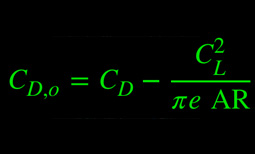 |
| Zero-Drag Configuration | A zero-drag configuration minimizes aerodynamic drag by optimizing the aircraft’s shape and design. Engineers use advanced materials and streamlined components to achieve this, enhancing fuel efficiency and performance. | 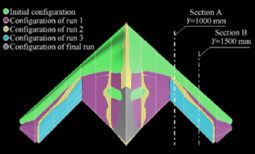 |
| Zero-Fuel Range | Zero-fuel range is the maximum distance an aircraft can fly without additional fuel onboard. This metric is used in performance planning and payload optimization, especially for long-haul flights. | 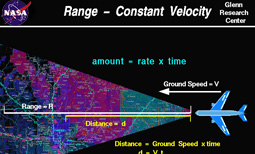 |
| Zero-Fuel Weight (ZFW) | Zero-fuel weight is the total aircraft weight without usable fuel. It includes the aircraft's structure, payload (passengers, cargo), and crew. ZFW is critical for calculating maximum takeoff weight and fuel load, ensuring the aircraft operates safely within structural and performance limits. | 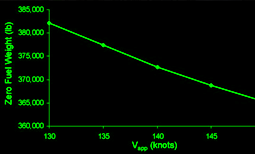 |
| Zero-G Flight | A zero-G flight simulates weightlessness by flying a parabolic trajectory. Used for astronaut training, scientific experiments, and recreational experiences, these flights provide moments of zero gravity during freefall phases. | 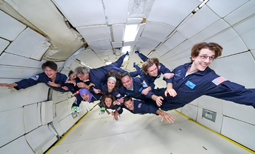 |
| Zero-Latency Response | Zero-latency response refers to instantaneous inputs from flight controls or systems, ensuring immediate reactions during critical maneuvers or emergencies. | 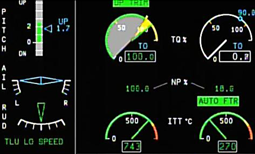 |
| Zero-Lift Angle of Attack | The zero-lift angle of attack is the wing angle relative to airflow where no lift is generated. This parameter is crucial for understanding aerodynamic efficiency and wing performance. |  |
| Zero-Lift Condition | A zero-lift condition occurs when the aircraft’s wings generate no lift, such as during vertical dives or specific test scenarios. Engineers study these conditions to understand drag and aerodynamic behavior. | 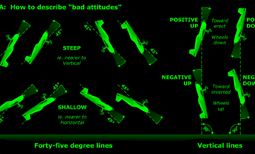 |
| Zero-Lift Drag | Zero-lift drag is the aerodynamic resistance experienced by an aircraft when generating no lift, such as during level flight. It comprises parasite drag and form drag, which engineers work to minimize through streamlined designs. | 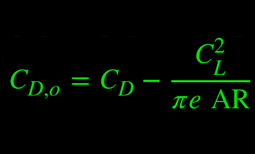 |
| Zero-Power Operation | Zero-power operation refers to systems that function without requiring additional electrical power, relying on mechanical or aerodynamic forces instead. Examples include ram air turbines used in emergencies. |  |
| Zero Side-Slip Angle | The zero side-slip angle is a flight condition where the aircraft aligns perfectly with the relative wind, avoiding lateral drift. Achieving this angle is crucial for efficient aerodynamics and fuel economy. | 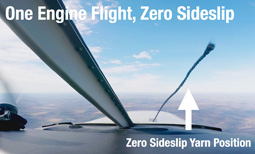 |
| Zero-Slip Approach | A zero-slip approach minimizes side forces during landing, ensuring a smooth touchdown. Pilots use coordinated rudder and aileron inputs to maintain alignment with the runway. | 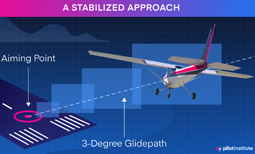 |
| Zero-Time Component | A zero-time component is an overhauled aircraft part restored to like-new condition. These components undergo rigorous testing and certification, ensuring reliability and performance equal to new parts. |  |
| Zero Visibility | Zero visibility describes conditions where pilots cannot see due to fog, heavy rain, or smoke. In such cases, pilots rely on instrument flight rules (IFR) and navigation aids like ILS (Instrument Landing System) for safe operations. | 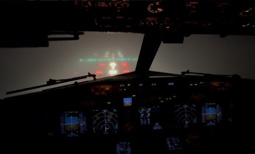 |
| ZFW Calculator | A ZFW calculator is a tool used by pilots and dispatchers to compute an aircraft's zero-fuel weight. It considers factors like payload, crew weight, and cargo distribution to determine safe operational limits. | 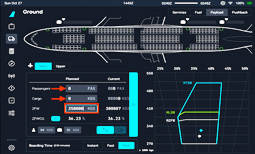 |
| Zipper Closure (Runway) | A zipper closure is a temporary or partial runway closure during maintenance or construction. It allows aircraft to use a portion of the runway while work is conducted, minimizing operational disruptions at airports. | 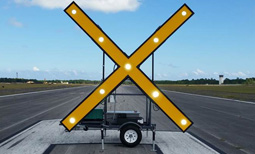 |
| Zonal Damage Evaluation | Zonal damage evaluation involves assessing structural damage to specific aircraft zones after incidents like bird strikes or lightning. This process ensures repairs are accurately targeted and structural integrity is restored. |  |
| Zonal Drying | Zonal drying systems in aircraft ensure moisture is removed from specific areas, such as the cargo hold or electronics compartments. These systems prevent corrosion, electrical malfunctions, and structural damage caused by condensation during flight. | 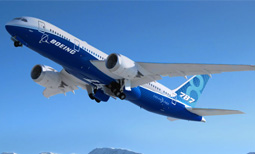 |
| Zonal Inspection | Zonal inspection is a maintenance process that divides the aircraft into zones for thorough examination. Technicians inspect each zone for damage, wear, and proper functionality of components, ensuring overall safety and compliance with regulatory standards. |  |
| Zonal Monitoring System | A zonal monitoring system tracks environmental conditions in specific aircraft zones, such as temperature, humidity, and pressure. It ensures optimal conditions for passengers and cargo. | 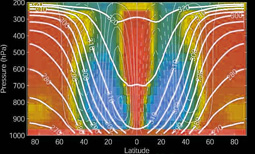 |
| Zonal Navigation | Zonal navigation refers to using specific airspace zones for efficient routing. It ensures reduced congestion and fuel consumption while maintaining safe separation between aircraft in busy air traffic regions. | 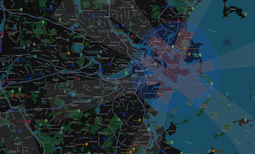 |
| Zone of Silence | A zone of silence refers to an area where radio signals cannot be received due to atmospheric conditions or obstructions. Pilots rely on alternate navigation methods in such areas, using dead reckoning or inertial navigation systems to maintain course. |  |
| Zone Temperature Control | Zone temperature control systems in aircraft regulate cabin and cargo area temperatures independently. This ensures passenger comfort and protects sensitive cargo, such as pharmaceuticals, by maintaining specific temperature ranges. | 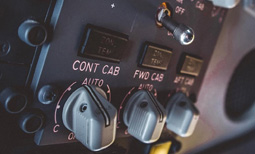 |
| Zoned Fuel Management | Zoned fuel management optimizes fuel distribution in an aircraft's tanks to maintain balance and stability. It ensures efficient fuel use during all flight phases while preventing structural stress. | 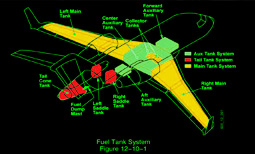 |
| Zoned Pressurization | Zoned pressurization systems maintain different pressure levels in various aircraft compartments. For instance, passenger cabins are pressurized for comfort, while cargo holds may be pressurized based on the cargo requirements. | 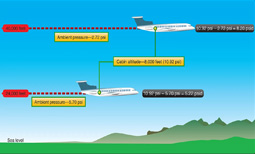 |
| Zoning Plan (Airport) | An airport zoning plan establishes land use regulations to prevent obstructions or hazards near runways. It ensures safe takeoffs, landings, and flight operations by restricting building heights and land activities within designated zones. | 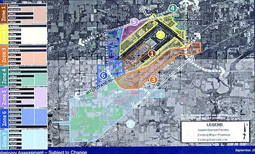 |
| Zoom Approach | A zoom approach is a high-speed descent followed by a rapid deceleration before landing. This technique is used in emergencies or military operations requiring quick landings. |  |
| Zoom Climb | A zoom climb is a high-angle ascent performed to gain maximum altitude quickly. This technique is often used in military aviation for combat maneuvers or reconnaissance missions. It utilizes the aircraft's kinetic energy and thrust for a rapid climb. | 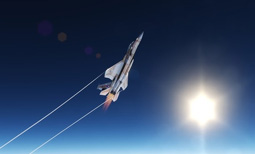 |
| Zulu Time | Zulu time, also known as Coordinated Universal Time (UTC), is the standard time reference used in aviation worldwide. Pilots and air traffic controllers use Zulu time to avoid confusion caused by time zones. It ensures consistency for flight planning, navigation, and communication across different regions. | 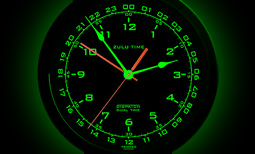 |
